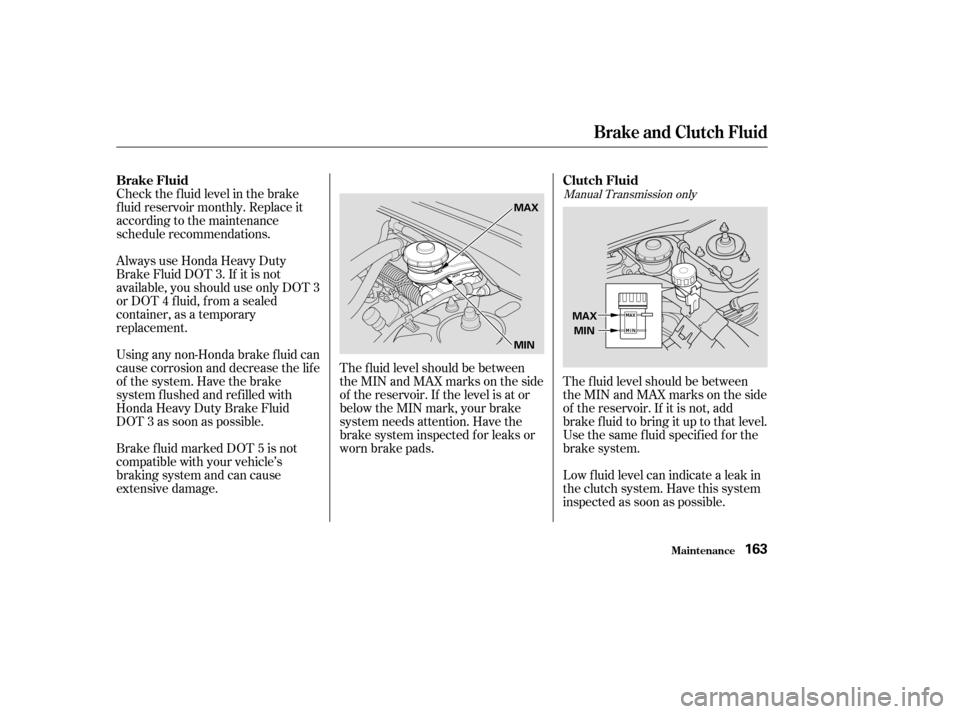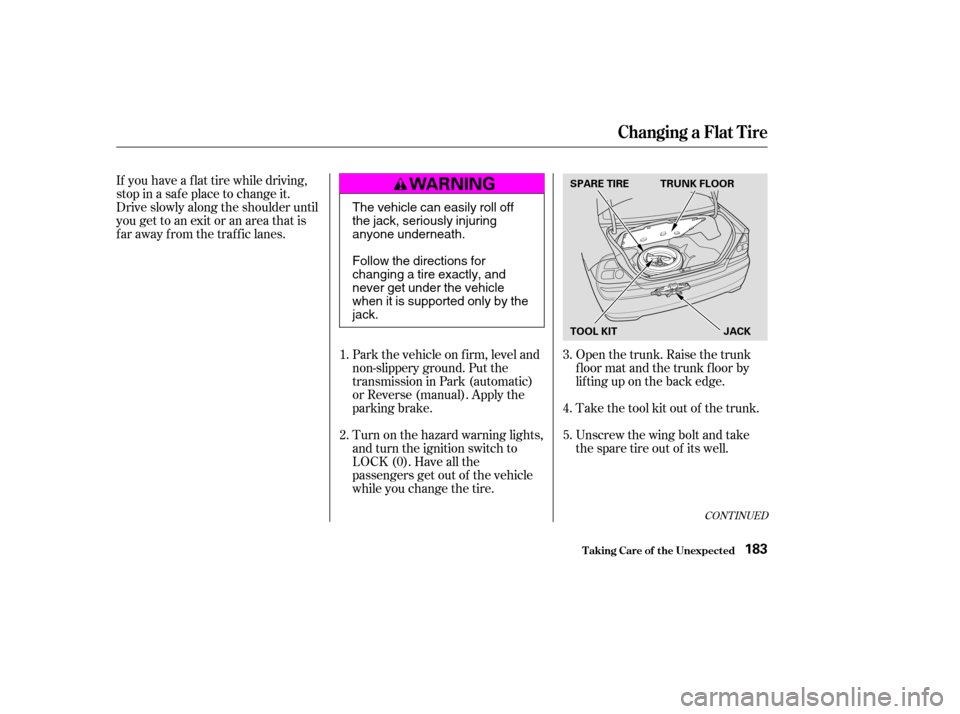Page 147 of 231

�Î
�Î
�Ì�Î
�Î �Î�Î
Maint enance148
miles x 1,000
km x 1,000
Service the items listed at the indicated distance (or time, if given).
Replace spark plugs
Inspect valve clearance
Replace automatic transmission fluid
Replace manual transmission fluid
Replace CVT transmission fluid
Inspect idle speed
Replace timing belt , inspect auto-tensioner and
water pump
Replace engine coolant
Replace brake fluid 10 16
((OOtthheerrwwiisseeaaddjjuussttoonnllyyiiffnnooiissyy))
((OOrreevveerryy33yyeeaarrss,,wwhhiicchheevveerrccoommeessffiirrsstt))
((OOrreevveerryy77yyeeaarrss,,wwhhiicchheevveerrccoommeessffiirrsstt))120,000 miles (192,000 km) or 10 years, then every
60,000 miles (96,000 km) or 5 years
Every 3 years (independent of mileage)
20 32
304840645080609670
112 80
128 90
144 100160 120192130208 140224
110176 150240
See timing belt on page for replacement information under special driving conditions.
Replace at 60,000 miles (96,000 km) or 3 years, then every 40,000 miles (64,000 km) or 2 years.
Replace at 60,000 miles (96,000 km) or 3 years, then every 30,000 miles (48,000 km) or 2 years.
1:2:
3: 162 1
2
,3
Maintenance Schedule for Severe Conditions
�����—�����—�����y�
�������������y���
�(���%�������y���
���
�y
Page 150 of 231
Fluid Locations
Maint enance151
ENGINE OIL
FILL CAPBRAKE FLUID
(Gray cap)
CLUTCH FLUID
(Gray cap)
WASHER FLUID
(Blue cap)
POWER STEERING
FLUID (Red cap)
AUTOMATIC
TRANSMISSION FLUID
DIPSTICK (CVT)
(Yellow loop)
RADIATOR CAP
ENGINE
COOLANT
RESERVOIR ENGINE OIL DIPSTICK
(Orange loop)
AUTOMATIC
TRANSMISSION
FLUID DIPSTICK
(Yellow loop)
�����—�����—�����y�
�������������y���
�(���%�������y���
�����y
Page 162 of 231

Check the f luid level in the brake
f luid reservoir monthly. Replace it
according to the maintenance
schedule recommendations.
Always use Honda Heavy Duty
Brake Fluid DOT 3. If it is not
available, you should use only DOT 3
or DOT 4 f luid, f rom a sealed
container, as a temporary
replacement.
Using any non-Honda brake f luid can
cause corrosion and decrease the lif e
of the system. Have the brake
system f lushed and ref illed with
Honda Heavy Duty Brake Fluid
DOT 3 as soon as possible.
Brake f luid marked DOT 5 is not
compatible with your vehicle’s
braking system and can cause
extensive damage.The f luid level should be between
theMINandMAXmarksontheside
of the reservoir. If the level is at or
below the MIN mark, your brake
system needs attention. Have the
brake system inspected f or leaks or
worn brake pads.
Low f luid level can indicate a leak in
the clutch system. Have this system
inspected as soon as possible.
The f luid level should be between
theMINandMAXmarksontheside
of the reservoir. If it is not, add
brake f luid to bring it up to that level.
Use the same fluid specified for the
brake system.Manual Transmission only
Brake and Clutch Fluid
Maint enance
Brake Fluid
Clutch Fluid
163
MAX
MINMAX
MIN
�����—�����—�����y�
�������������y���
�(���%�������y���
�����y
Page 167 of 231
Open the trunk and remove the
socket f rom the light assembly by
turning it one-quarter turn counter-
clockwise.Reinstall the socket. Turn it
clockwise until it locks. Make sure
the new bulb is working.
Pull the bulb straight out of its
socket.
Push the new bulb straight into
the socket until it bottoms. 3.
2.
1.
Lights
Maint enance
Replacing a High-mount Brake
Light Bulb
168
SOCKET
BULB
�����—�����—�����y�
���������
���y���
�(���%�������y���
���
�y
Page 176 of 231

�´Because your Honda has limited tire
clearance, mount only SAE Class ‘‘S’’
cable-type traction devices, with
rubber chain tensioners on the f ront
tires. Use traction devices only when
required by driving conditions or
local laws. Make sure they are the
correct size f or your tires. Make link-
type ‘‘chains’’ should not be used.
When installing cables, f ollow the
manuf acturer’s instructions, and
mount them as tight as you can.
Make sure they are not contacting
the brake lines or suspension. Drive
slowly with them installed. If you
hear them coming into contact with
the body or chassis, stop and
investigate. Remove them as soon as
you begin driving on cleared roads.
Tires marked ‘‘M S’’ or ‘‘All
Season’’ on the sidewall have an all-
weather tread design suitable for
most winter driving conditions.
For the best perf ormance in snowy
or icy conditions, you should install
snow tires or tire chains. They may
be required by local laws under
certain conditions.
If you mount snow tires on your
Honda, make sure they are radial
tires of the same size and load range
as original tires. Mount snow tires on
all f our wheels. The traction
provided by snow tires on dry roads
maybelowerthanyouroriginaltires.
Check with the tire dealer f or
maximum speed recommendations. Tire Chains
Snow T ires
Winter Driving
Tires
Maint enance177
NOTICE:
Traction devices that are the
wrong size or improperly installed can
damage your vehicle’s brake lines,
suspension, body, and wheels. Stop
driving if they are hitting any part of
the vehicle.
�����—�����—�����y�
�����������
�y���
�(���%�������y���
�����y
Page 178 of 231

If you need to park your vehicle f or
an extended period (more than one
month), there are several things you
should do to prepare it f or storage.
Proper preparation helps prevent
deterioration and makes it easier to
get your vehicle back on the road. If
possible, store your vehicle indoors.Fill the f uel tank.
Change the engine oil and f ilter. Block the rear wheels.
If the vehicle is to be stored f or a
longer period, it should be
supported on jackstands so the
tires are of f the ground.
Leave one window open slightly (if
the car is being stored indoors).
Disconnect the battery.
Support the f ront wiper blade
arms with a f olded towel or rag so
they do not touch the windshield.
To minimize sticking, apply a
silicone spray lubricant to all door
and trunk seals. Also, apply a
vehiclebodywaxtothepainted
surfaces that mate with the door
and trunk seals.
Wash and dry the exterior
completely.
Cleantheinterior.Makesurethe
carpeting, floor mats, etc. are
completely dry.
Leave the parking brake off. Put
the transmission in Reverse
(5-speed manual) or Park
(automatic). Cover the vehicle with a
‘‘breathable’’ cover, one made
f rom a porous material such as
cotton. Non-porous materials, such
as plastic sheeting, trap moisture,
which can damage the paint.
If possible, run the engine f or a
while periodically until it reaches
full operating temperature (the
cooling f an cycle on and of f twice).
Pref erably once a month.
If you store your vehicle f or 12
months or longer, have your Honda
dealer perf orm the inspections called
f or in the 24 months/30,000 miles
maintenance schedule (Normal
Conditions) as soon as you take it
out of storage (see page ). The
replacements called f or in the
maintenance schedule are not
needed unless the vehicle has
actually reached that time or mileage. 145
Vehicle Storage
Maint enance179
�����—�����—�����y�
�������������y���
�(���%�������y���
�����y
Page 180 of 231

This section covers the more
common problems that motorists
experience with their vehicles. It
gives you inf ormation about how to
safely evaluate the problem and what
to do to correct it. If the problem has
stranded you on the side of the road,
you may be able to get going again.
If not, you will also f ind instructions
on getting your vehicle towed.......................
Compact Spare Tire . 182
....................
Changing a Flat Tire . 183
.............
If the Engine Won’t Start . 189
................................
Jump Starting . 191
..............
If the Engine Overheats . 192
.........
Low Oil Pressure Indicator . 195
..........
Charging System Indicator . 195
.......
Malf unction Indicator Lamp . 196
...............
Brake System Indicator . 197
..................
Closing the Moonroof . 198
..............................................
Fuses . 199
..........................
Fuse Locations . 201
......................
Emergency Towing . 203
Taking Care of the Unexpected
T aking Care of t he Unexpect ed181
�����—�����—�����y�
�������������y���
�(���%�������y���
�����y
Page 182 of 231

Park the vehicle on f irm, level and
non-slippery ground. Put the
transmission in Park (automatic)
or Reverse (manual). Apply the
parking brake.
Turn on the hazard warning lights,
and turn the ignition switch to
LOCK (0). Have all the
passengers get out of the vehicle
while you change the tire.Take the tool kit out of the trunk.
Unscrew the wing bolt and take
the spare tire out of its well.
Open the trunk. Raise the trunk
f loor mat and the trunk f loor by
lif ting up on the back edge.
If you have a f lat tire while driving,
stop in a saf e place to change it.
Drive slowly along the shoulder until
you get to an exit or an area that is
far away from the traffic lanes.
5.
4.
3.
2.
1.
CONT INUED
Changing a Flat T ire
T aking Care of t he Unexpect ed183
SPARE TIRE TRUNK FLOOR
TOOL KIT JACK
The vehicle can easily roll off
the jack, seriously injuring
anyone underneath.
Follow the directions for
changing a tire exactly, and
never get under the vehicle
when it is supported only by thejack.
�����—�����—�����y�
�������������y���
�(���%�������y���
�����y